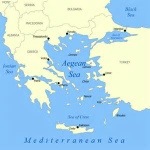 In September, 1922, Mustapha Kemal Ataturk, the victorious revolutionary ruler of Turkey, led his troops into Smyrna (now Izmir) a predominantly Christian city, as a flotilla of 27 Allied warships– including three American destroyers– looked on. The Turks soon proceeded to indulge in an orgy of pillage, rape and slaughter that the Western powers anxious to protect their oil and trade interests in Turkey, condoned by their silence and refusal to intervene. Turkish forces then set fire to the legendary city and totally destroyed it. There followed a massive cover-up by tacit agreement of the Western Allies who had defeated Turkey and Germany during World War I. By 1923 Smyrna’s demise was all but expunged from historical memor.
In September, 1922, Mustapha Kemal Ataturk, the victorious revolutionary ruler of Turkey, led his troops into Smyrna (now Izmir) a predominantly Christian city, as a flotilla of 27 Allied warships– including three American destroyers– looked on. The Turks soon proceeded to indulge in an orgy of pillage, rape and slaughter that the Western powers anxious to protect their oil and trade interests in Turkey, condoned by their silence and refusal to intervene. Turkish forces then set fire to the legendary city and totally destroyed it. There followed a massive cover-up by tacit agreement of the Western Allies who had defeated Turkey and Germany during World War I. By 1923 Smyrna’s demise was all but expunged from historical memor.
– Smyrna 1922: The Destruction of a City, Marjorie Housepian Dobkin
Estimates of Greek and Armenian deaths range from 10,000 to 100,000. Nearly 500,000 Greeks were forced to emigrate or detained in concentration camps.
Prior to the Turkish conquest, Smyrna was a Greek commercial enclave on the Aegean coast of Asia Minor where Christians lived peacefully among the Turks. In fact, most ethnically Greek residents of Smyrna spoke Turkish as their primary language.
While Ataturk’s violence was extreme, it was not entirely unprovoked. Greek troops had wiped out a Turkish brigade in May of 1919, after the end of the First World War and claimed Smyrna as part of Greece. A military administration was formed by Greece in and around Smyrna.
The Greek premier Venizelos had plans to annex Smyrna and he seemed to be realizing his objective in the Treaty of Sèvres signed on August 10, 1920.[16] (However, this treaty was not ratified by the parties and replaced by the Treaty of Peace of Lausanne.)
Smyrna (Ancient Greek: Σμύρνη or Σμύρνα) was an ancient city located at a central and strategic point on the Aegean coast of Anatolia. Due to its advantageous port conditions, its ease of defence and its good inland connections, Smyrna rose to prominence.

The ancient city is located at two sites within modern İzmir, Turkey. The first site, probably founded indigenously, rose to prominence during the Archaic Period as one of the principal ancient Greek settlements in western Anatolia. The second, whose foundation is associated with Alexander the Great, reached metropolitan proportions during the period of the Roman Empire. Most of the present-day remains date from the Roman era, the majority from after a 2nd century AD earthquake.



